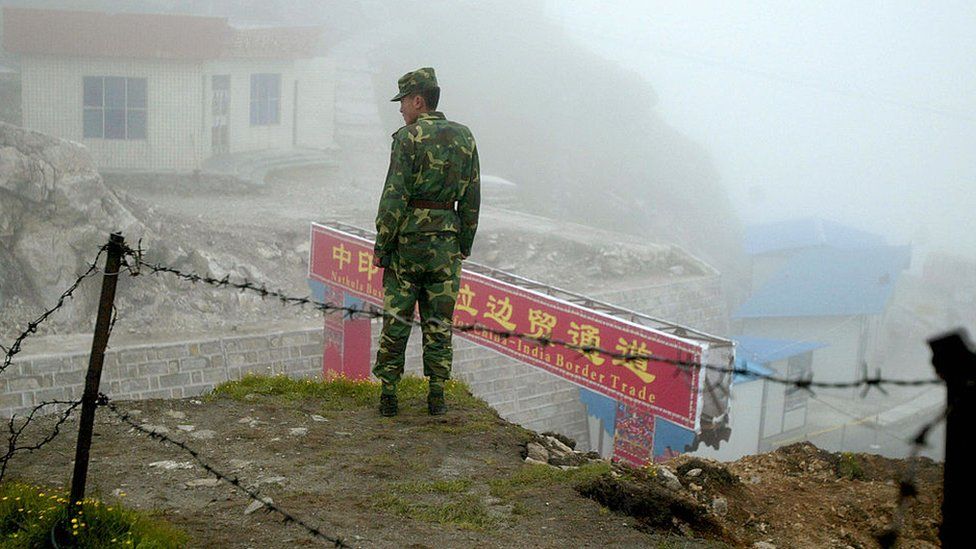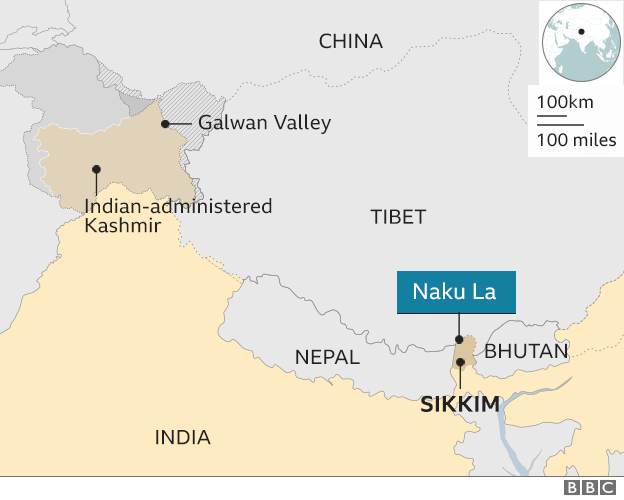
Chinese and Indian forces in a new border clash
Indian media reported that Chinese and Indian forces clashed again in a disputed border area, resulting in casualties on both sides.
The accident took place in North Sikkim on Wednesday. The Indian army said that a “minor” incident had been “resolved”.
Tensions are high along the world’s longest disputed border. Both sides claim large areas of land.
At least 20 Indian soldiers were killed in clashes in the Ladakh region last June.
What happened in the last accident?
Media reports stated that the accident occurred in Nako, not north of Sikkim. Sikkim is an Indian state located between Bhutan and Nepal, some 2,500 kilometers (1,500 miles) east of the Ladakh region.
Officials said a Chinese patrol tried to enter India and were forced to return. Some reports stated that sticks and rocks were used, but that there were no gunshots.
A statement by the Indian army downplayed the incident, saying, “There was a slight confrontation in Nako, not north of Sikkim, on January 20, 2021, and the same problem was resolved by local leaders in accordance with the protocols in place.”
A source told The Times of India that the two sides brought reinforcements after a “fight” but that there was no shooting and the situation was under control.
Chinese Foreign Ministry spokesman Zhao Lijian did not give details of the incident, but said that Chinese forces are “committed to supporting peace” and urged India to “refrain from actions that might escalate or complicate the situation along the border.”
The editor-in-chief of the Chinese state Global Times tweeted that “there is no record of this clash in the patrol record on the Chinese side.”

Ignition and dialogue points
Vikas Pandey analysis, BBC News, Delhi
The latest reports on the skirmishes show that tensions remain high. The Indian Army’s statement shows that both countries remain keen to keep the path of dialogue open and do not want the skirmishes to derail the process.
They have held several talks at the military level to ease tensions, but so far nothing concrete has emerged.
Forces are still facing each other at several hotspots along their disputed borders.
Some former Indian officers say that such exchanges are unavoidable when the situation is extremely volatile. But they agree that talks must continue because neither country will want a war – not even a limited war.
Why are there border disputes?
Much of the 3,440 km (2,100 mi) boundary is poorly defined. Rivers, lakes, and ice caps mean the streak can change, bringing soldiers face to face at many points, sometimes leading to confrontations.
There was a minor clash last May in Nako-no, at an altitude of over 5,000 meters (16,000 feet). A month later, a deadly clash erupted In the Gilwan Valley in Ladakh. In addition to the Indian deaths, China was also reported to have incurred losses although it made no official comment.
Since the brutal fist fight there, in which there was no gunfire, the two sides have held de-escalation talks. The ninth round took place between military leaders on Sunday in eastern Ladakh, but there were no details of any agreements.
The nuclear-armed neighbors have a lot to lose, with China being one of India’s biggest trading partners.
Relations soured amid the border confrontation. Both have intensified infrastructure construction along some border areas.
The government of India has it More than 200 Chinese apps have also been blocked, Citing cybersecurity concerns.
The two countries fought only one war, in 1962, when India suffered a heavy defeat.
An agreement was signed in 1996 prohibiting the use of weapons and explosives from the Line of Actual Control, as the disputed borders are known. It held up, although China did He accused Indian forces of firing warning shots in Ladakh Last September.
What is the strategic importance of SICIM?
The tiny eastern Himalayan region has been a major flashpoint between India and China for decades. It witnessed clashes in the 1962 war. Five years later, fighting along its border left several hundred soldiers dead on both sides.
The former kingdom was an Indian protectorate at the time, and it only became the 22nd state in the country after a referendum in 1975.
Sikkim is located near a soaring plateau known as Doklam in India and Donglang in China.
India fears that access by larger Chinese roads to the plateau threatens the strategically endangered Indian “chicken neck”, the Siliguri Corridor 20 kilometers (12 miles) wide that connects seven northeastern states, including Assam, with the rest of the country .
Borders in Sikkim are also important for another reason. Indian military experts say it is the only region from which India can mount an offensive response to a Chinese incursion, and the only stretch of the Himalayan border where Indian forces have a terrain advantage and a tactical advantage. They have a higher ground, and Chinese positions there are sandwiched between India and Bhutan.

“Totale ninja voor sociale media. Introvert. Maker. Tv-fan. Bekroonde ondernemer. Webnerd. Gecertificeerde lezer.”
